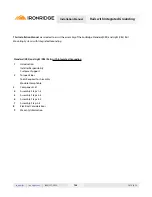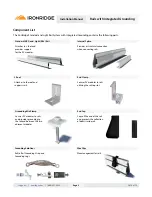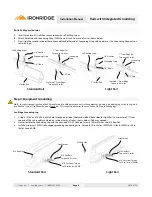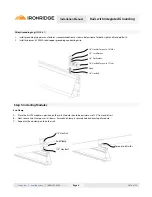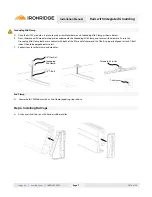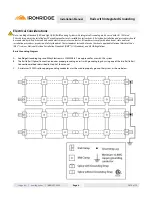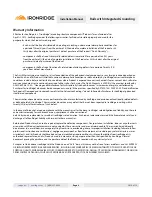
Page 4
|
| (800) 227-9523
2013 v1.13
Rails with Integrated Grounding
Installation Manual
A. Determine the appropriate flashing required for your roof type and
project. Install flashing per manufacturer’s requirements.
B. Mount all the L-feet to the roof in the desired locations using a minimum
5/16” x 3” long Lag Bolt. The 5/16” Lag Bolt attached to a structural roof
member such as a rafter. For metal or tile roofs, install a mount suitable
for the application, per mount manufacturer’s requirements.
Note:
The roof attachment spacings are defined by many variables such as site
conditions, rail type and roof structure. Refer to the IronRidge Certification letters
or online Design Assistant to determine appropriate attachment spacing.
Assembly Steps
Step 1. Install Applicable Roof Flashing and L-feet
Step 3. Rail to Rail Connections
Step 2. Attaching Rails To L-Feet
A. Slide the 3/8” bolts into rail side slot. Space bolts to match the L-feet
spacing.
B. Loosely attach rail to L-feet using 3/8” hardware. Position rail at desired
height and level. Once level torque 3/8” hardware to 236 in-lbs (dry).
Move to Step 3 for Rail to Rail Connections then repeat Step 2 for each
L-foot connection.
Note:
Attaching rails to L-Feet may be performed before or after making rail-to-
rail connections, depending on the installer’s preference.
Note:
This connection requires proper grounding on rails with grounding lugs by using one of the two following Rail to Rail Connection
methods. For rails without lugs, use the Internal Splice and self-drilling screws without the grounding strap and star washers (See Page 8). For
rows exceeding 50 feet of rail, IronRidge recommends the Rail to Rail Expansion Joint. Expansion joints prevent the potential buckling of rails
due to thermal expansion. At the installer’s discretion, a Rail to Rail Expansion Joint may also be used at lengths of less than 50 feet of rail.
Rail to Rail (Basic) Connection
A. Insert internal splice into first rail then secure splice with hardware and Grounding Strap (9AWG). Attach and assemble as shown.
B. Next, slide second rail over splice and secure with hardware on opposite end of Grounding Strap.
C. Repeat this procedure for remaining Rail to Rail Connections. (Use Grounding Strap only on rails with lugs.)
Standard
Rail
Light
Rail
Centered 1” From Edge
Torque to 84 in-lbs
6” inside Rail
Self-drilling screw
Grounding
Strap
Star Washer
Centered 1” From Edge
Torque to 84 in-lbs
Centered 1” From Edge
Torque to 84 in-lbs
3” inside Rail
Self-drilling screw
Grounding
Strap
Star Washer
Centered 1” From Edge
Torque to 84 in-lbs


